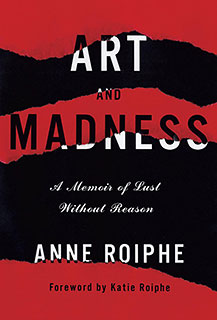Art and Madness: A Memoir of Lust Without Reason
Anne Roiphe
By
Barbara Finkelstein
Published: May 12, 2011
Category:
Memoir
I can’t be the only person smitten by Anne Roiphe’s “Art and Madness: A Memoir of Lust Without Reason.” The New York Public Library has forty-one copies of the book in branches from 67th Street to Todt Hill-Westerleigh, and as of this writing, only thirteen are available. Forty-one copies. Why do so many people want to read Roiphe’s book?
They’re not reading it because of spectacular reviews. In the New York Times,
Joyce Johnson faulted Roiphe for not pursuing a "tough line of inquiry" into herself. In another Times review,
Janet Maslin called Roiphe “a passive, largely unformed character who is just reacting to the advances of others” and said Roiphe’s sexual misadventures were a "stereotypical" response to her privileged Park Avenue upbringing. And
Liesl Schillinger in The Daily Beast chided Roiphe for presuming that her own experience spoke for a generation of pre-feminist women.
It’s not hard to skewer this book. Like all memoirs, “Art and Madness” is subjective, and that’s an understatement. In fact, it is hard to know how seriously to take Roiphe’s implied argument: That she would not have gone to bed with every male artist of the early 1960s if she had had a feminist movement to rescue her.
Anne Roiphe is certainly not the first writer to record a less than savory phase of her life. I read memoirs like hers to see how people survived their tough years.. Patti Smith just got a National Book Award for her spin on this theme. But if you read Just Kids — which I loved — you’ll notice that Smith doesn’t exactly pursue a tough line of inquiry into herself.
That’s because the tough line of inquiry is made for the therapist’s couch, not necessarily for a memoir. [To buy “Art and Madness” from Amazon, click here. For the Kindle edition, click here.]
If you can look past the unwitting lies and half-truths that bedevil all memoirs, you’ll come face to face with something in “Art and Madness” that is profoundly moving.
Truth.
Yes, in this vexing memoir, you will read an account of a young woman’s mistakes in judgment and the lasting damage they inflicted on her daughter Emily. Some mistakes life will not forgive, and ain’t that the truth?
Here’s what Roiphe subjected Emily to. A word of caution: It’s bad.
— In the middle of the night, Roiphe wakes Emily up and takes her along on an impromptu hookup with
Doc Humes, a literary footnote who co-founded The Paris Review.
— Roiphe makes out with one of George Plimpton’s friends in Plimpton’s bedroom, where one-year-old Emily is sleeping on a pile of coats. On the way home in a taxi, Emily weeps inconsolably.
— Emily detects the smell of scotch on Jason Robards’ breath. She asks, "Where is the bottle?" Emily is sixteen months old.
— Roiphe brings Plimpton home with her one night. In the morning, Emily gets into bed with them. "Does he have a penis?" she asks. "Let’s look," Roiphe says.
Kee-rist.
These assignations represent a fraction of the romps Roiphe describes in a series of non-chronological vignettes. Space does not permit descriptions of trysts with William Styron and Bernard Malamud.
While I’m hardly qualified to talk about cause and effect in matters of human psychology, I’m guessing that Emily’s adult heroin addiction and sexual promiscuity — resulting in full-blown AIDS — might have roots in the chaos of her early life.
Roiphe herself implies a connection between her libertinism and her daughter’s emotional problems. After one of her dates, Roiphe says: "I must stop [Emily] from screaming if I [go] into another room. I must find out why she wakes in the middle of the night with such terrors that her entire body shakes in my arms. One night, when I could hardly calm her at all and great sobbing sounds were coming from her small chest, I thought about the ocean and how I could walk into it holding her in my arms and we would both be at peace."
Nearly all of Roiphe’s reviewers observe unkindly that Roiphe never names Emily but refers to her only as the "child." But isn’t that the sad truth? Emily was a child when Roiphe was bedding famous male writers with all the avidity that the Navy Seals brought to their pursuit of Bin Laden. Eventually, Roiphe left her wild life. Emily, however, may have gotten stuck there, as innocents do, through no fault of her own.
Why are people reading Roiphe’s book?
Because sometimes you owe your kids an apology.
I think “Art and Madness” is an apology to Emily. I think Roiphe is telling her daughter, now a fifty-year-old AIDS survivor, that she — Roiphe — was once young, and that her mind was clouded by a lot of untested assumptions about life:
That male writers, no matter how caddish, must be humored on their path to greatness.
That a little girl will thrive in an apartment full of men who drink until they pass out.
That literature could do more good than science, although God knows that the greatest work of fiction will never cure AIDS, and that the only hope is science.
What? You never had an idiotic thought in your life?
If you’re like Roiphe’s critics, who seem to have forgotten how hard it is to be young and unsure of yourself, don’t read this book. But if you are curious about a bygone world that ate its own and the children of others, welcome to Art and Madness. By the last page, you may be traumatized enough to start reading the book all over again.
I was.


